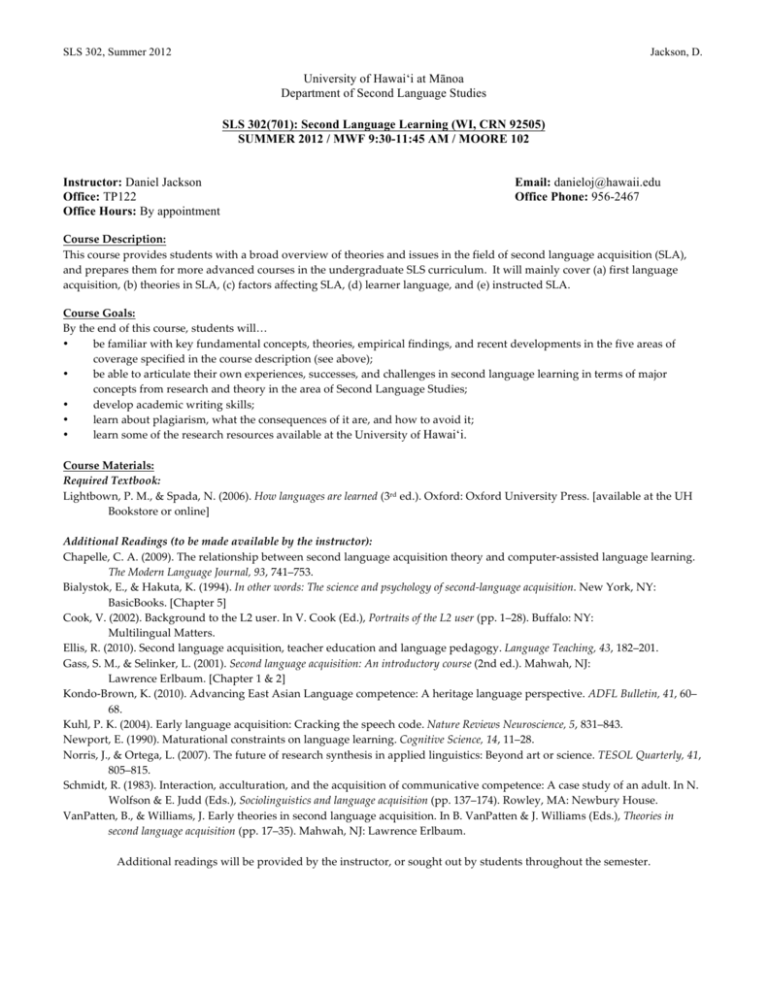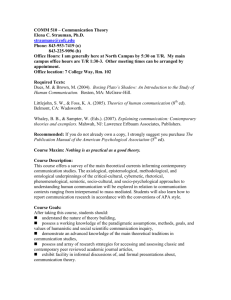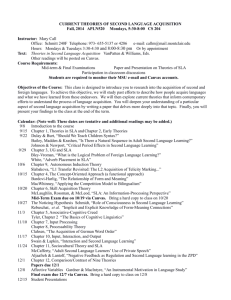University of Hawai'i at Mānoa Department of Second Language
advertisement

SLS 302, Summer 2012 Jackson, D. University of Hawai‘i at Mānoa Department of Second Language Studies SLS 302(701): Second Language Learning (WI, CRN 92505) SUMMER 2012 / MWF 9:30-11:45 AM / MOORE 102 Instructor: Daniel Jackson Office: TP122 Office Hours: By appointment Email: danieloj@hawaii.edu Office Phone: 956-2467 Course Description: This course provides students with a broad overview of theories and issues in the field of second language acquisition (SLA), and prepares them for more advanced courses in the undergraduate SLS curriculum. It will mainly cover (a) first language acquisition, (b) theories in SLA, (c) factors affecting SLA, (d) learner language, and (e) instructed SLA. Course Goals: By the end of this course, students will… • be familiar with key fundamental concepts, theories, empirical findings, and recent developments in the five areas of coverage specified in the course description (see above); • be able to articulate their own experiences, successes, and challenges in second language learning in terms of major concepts from research and theory in the area of Second Language Studies; • develop academic writing skills; • learn about plagiarism, what the consequences of it are, and how to avoid it; • learn some of the research resources available at the University of Hawai‘i. Course Materials: Required Textbook: Lightbown, P. M., & Spada, N. (2006). How languages are learned (3rd ed.). Oxford: Oxford University Press. [available at the UH Bookstore or online] Additional Readings (to be made available by the instructor): Chapelle, C. A. (2009). The relationship between second language acquisition theory and computer-­‐‑assisted language learning. The Modern Language Journal, 93, 741–753. Bialystok, E., & Hakuta, K. (1994). In other words: The science and psychology of second-­‐‑language acquisition. New York, NY: BasicBooks. [Chapter 5] Cook, V. (2002). Background to the L2 user. In V. Cook (Ed.), Portraits of the L2 user (pp. 1–28). Buffalo: NY: Multilingual Matters. Ellis, R. (2010). Second language acquisition, teacher education and language pedagogy. Language Teaching, 43, 182–201. Gass, S. M., & Selinker, L. (2001). Second language acquisition: An introductory course (2nd ed.). Mahwah, NJ: Lawrence Erlbaum. [Chapter 1 & 2] Kondo-­‐‑Brown, K. (2010). Advancing East Asian Language competence: A heritage language perspective. ADFL Bulletin, 41, 60– 68. Kuhl, P. K. (2004). Early language acquisition: Cracking the speech code. Nature Reviews Neuroscience, 5, 831–843. Newport, E. (1990). Maturational constraints on language learning. Cognitive Science, 14, 11–28. Norris, J., & Ortega, L. (2007). The future of research synthesis in applied linguistics: Beyond art or science. TESOL Quarterly, 41, 805–815. Schmidt, R. (1983). Interaction, acculturation, and the acquisition of communicative competence: A case study of an adult. In N. Wolfson & E. Judd (Eds.), Sociolinguistics and language acquisition (pp. 137–174). Rowley, MA: Newbury House. VanPatten, B., & Williams, J. Early theories in second language acquisition. In B. VanPatten & J. Williams (Eds.), Theories in second language acquisition (pp. 17–35). Mahwah, NJ: Lawrence Erlbaum. Additional readings will be provided by the instructor, or sought out by students throughout the semester. SLS 302, Summer 2012 Jackson, D. Course Requirements: This course will utilize both cooperative and individual learning methods including, but not restricted to, the following: 1. ACTIVE participation in ALL discussions/lectures. Your attendance and active participation in class is essential to your success in it. This includes coming to each class on time, prepared to discuss readings and other assignments. 2. Reading all of the assigned materials. Students are all expected to have read the assigned readings before the date they are listed on the course schedule. You are expected to have read the material thoroughly and be prepared to discuss the reading in class. 3. Internet/email access. Important information including reminders, assignments, classroom changes, and other announcement, as well as submission of several assignments will be done online. It is important for students to check their UH email regularly (at least twice a day) as well as the class website on Laulima. In addition, several articles and book chapters will also be placed on the class website to supplement the textbook. 4. Free writing. Five to ten-­‐‑minute individual in-­‐‑class written responses to questions arising from the homework reading assignments or the class discussion. This task is to check understanding of important concepts, to promote reflection and dialogue, and to encourage you to be active, critical readers. 5. TWO group presentations. You will be assigned to work in groups to discuss relevant concepts introduced in each unit, and to give presentations based on discussions. This will give you a chance to review the unit and prepare for the exams. The use of some visual media (handouts, PowerPoint, etc.) will be expected. All group members are expected to contribute and participate equally; thus, all group members will receive the same grade for this assignment. 6. FOUR reaction papers (two pages max.) on topics related to the group presentations, or other topics to be negotiated. 7. A term paper that reviews the literature on a subject negotiated with the instructor (8-­‐‑10 pages). 8. A midterm exam (in-­‐‑class). 9. A final take-­‐‑home exam. Grading: This course will be graded with a simple numerical system whereby each activity and assignment will be allotted a maximum number of points. Total Points Total counts per count Attendance & participation* 100 970-­‐‑1000pts A+ Free writing (FW) 10 20 200 930-­‐‑969pts A 900-­‐‑929pts A-­‐‑ Group presentation (GP) 2 50 100 870-­‐‑899pts B+ Reaction paper (RP) 4 25 100 830-­‐‑869pts B Midterm exam 1 150 150 800-­‐‑829pts B-­‐‑ Term paper 1 200 200 770-­‐‑799pts C+ 5 730-­‐‑769pts C Proposal & Bibliography 1 1 30 10 700-­‐‑729pts C-­‐‑ Annotated bibliography 10 1 50 670-­‐‑699pts D+ Final paper 1 1 120 5 1 200 630-­‐‑669pts D Final exam Total 1 150 150 1000 600-­‐‑629pts D-­‐‑ Below 600pts F Attendance: Ten points will be deducted for each unexcused absence. We will begin class on time each day so punctuality is also important. Late entrances disrupt the class for everyone, so please show respect for your classmates and teacher and be in your seat and ready to begin by 9:30. Three instances of tardiness will be will be considered an absence. Late Work: It is important that you keep up with the reading and writing assignments in this course. As an added incentive, late papers and homework will receive reduced points, unless you have a verifiable emergency or a doctor'ʹs notice. Please do not ask for extensions on deadlines. SLS 302, Summer 2012 Jackson, D. Writing Intensive Course: This is a writing intensive course, in which you not only “learn to write,” but also “write to learn.” Please see the following web site for details http://www.hawaii.edu/gened/focus/w.htm. To help you develop your writing, some class time will be spent on writing instruction. Also, I am available for individualized tutoring during office hours. Formatting Assignments: For all the writing assignments, please use the American Psychological Association (APA) format for referencing and bibliographies. Models can be found at Hamilton Library, in course readings and handouts, and online at http://owl.english.purdue.edu/handouts/research/r_apa.html. * Other useful websites are: http://owl.english.purdue.edu/owl/resource/560/01/ http://linguistics.byu.edu/faculty/henrichsenl/apa/APA04.html http://www.lib.monash.edu.au/tutorials/citing/apa.html http://www.nova.edu/library/dils/lessons/apa/ http://www.asian-­‐‑efl-­‐‑journal.com/Referencing%20Style%20for%20the%20Asian%20EFL%20Journal.pdf http://www.docstyles.com/archive/apacrib.pdf http://www.library.uq.edu.au/training/citation/apa.pdf http://www.lib.unimelb.edu.au/recite/citations/apa6/generalNotes.html Papers should be presented in 8.5” x 11” format with 1” margins all around, double-­‐‑spaced, preferably in Times New Roman typeface, and with 12-­‐‑point font size. Writing assignments electronically submitted through Laulima should be in either .doc or .docx file format. The file name should have the student’s first and last name and the name of the assignment. The term paper should have references and citation in APA format and should be written in academic English. Academic (Dis)honesty: Many of your assignments for this course involve integrating information from published sources into your own writing. This means that you need to be careful not to plagiarize. According to the UH Student Conduct Code (p. 9): The term “plagiarism” includes, but is not limited to, the use, by paraphrase or direct quotation, of the published or unpublished work of another person without full and clear acknowledgement. It also includes the unacknowledged use of materials prepared by another person or agency engaged in the selling of term papers or other academic materials. (p. 9) For more information, please visit the following page http://www.studentaffairs.manoa.hawaii.edu/policies/conduct_code/. Plagiarism is a serious threat to academic honesty, and it may result in suspension or expulsion from the university. Cell Phones, etc. Please turn off or silence all cell phones or other potentially disruptive electronic devices during class! Important Dates: First Day of Instruction July 2 (M) Independence Day July 4 (W) Last Day of Instruction August 10 (F)





